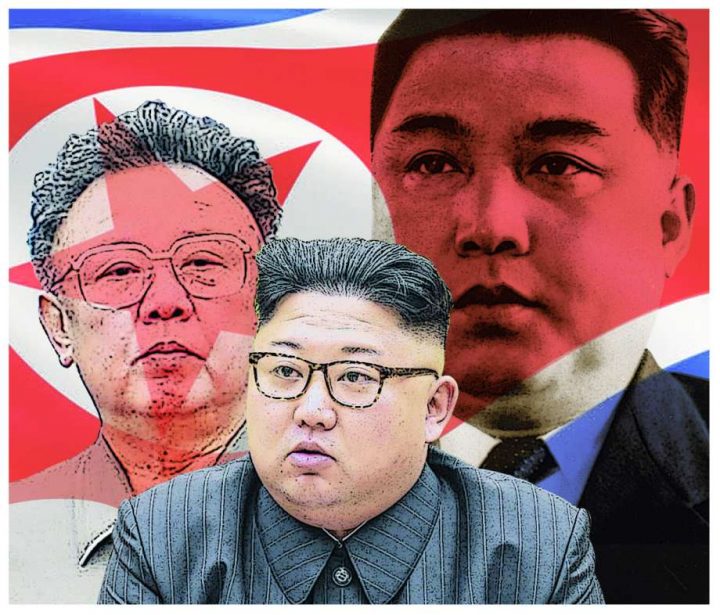In 1905, Japan made Korea its protectorate. Under the Japanese, Koreans were deprived of land and food, forced into labor, forbidden to publish newspapers, required to adopt Japanese names and worship Shinto shrines, victimized by medical experiments, bullied in school, insulted, raped, tortured and killed.
Some Koreans rebelled. Thousands traveled north to Manchuria, becoming guerrilla fighters to combat the Japanese occupation. Many, including Kim Il Sung, were attracted to Communism’s promise of equality. As North Korea’s future first president (1949-94), Kim insisted on creating a self-reliant North Korea, independent of foreign influence.
Some Koreans fled, including Syngman Rhee, who unsuccessfully tried in 1905 to convince U.S. President Theodore Roosevelt to preserve Korean independence. As South Korea’s first president (1948-60), Rhee was anti-Communist, English-speaking and Christian, a religion whose message of equality appealed to Korean lower classes oppressed by the Japanese and traditional Korean hierarchy. Yet Rhee was violently authoritarian and corrupt. He incensed the U.S. by trying to sabotage Korean War armistice negotiations.
Some Koreans cooperated with the Japanese, including Park Chung Hee, who fought within Japan’s Imperial Army against Korean guerrillas. As South Korea’s third president (1963-79), Park secured economic aid from Japan, pushed for more U.S. troops, bribed U.S. legislators for military aid, imposed martial law and authorized nuclear weapons development before yielding to U.S. pressure.
When World War II Allies liberated Korea from Japan, Soviet troops in the North were rapaciously cruel to Koreans until Stalin, of all people, ordered Soviets to behave. Meanwhile in the South, because of noble U.S. intentions of treating Japan with respect, U.S. leaders infuriated Koreans by initially allowing hated Japanese officials to continue governing Korea.
Popular left-wing movements became increasingly shunned by the U.S. military government, which found it easier to work with conservative, wealthier, right-wing Koreans who spoke English and had typically cooperated with the Japanese.
Like a magnet, the peninsula grew polarized. In the North, those suspected of supporting Japanese, Americans, or Korean upper classes were executed or fled. In the South, those suspected of supporting left-wing movements were executed or fled.
With the Korean War’s outbreak, atrocities continued on both sides. U.S. troops were revolted by South Korean atrocities against suspected Communists, yet U.S. forces carpet-bombed street after street of North Korea, dropping napalm and pulverizing most cities and residences.
After the war, North Korea was engulfed by the brutal, hypocritical leadership of Kim Il Sung, whose commands for non-selfish labor fed his selfish desire to be worshipped as the all-perfect Father, a compassionate Santa Claus whose molten iron grip mercilessly punished the population. Koreans who didn’t believe Kim Il Sung was magnificent learned to fake it. Even the USSR and China favored stationing U.S. troops in South Korea to deter Kim.
Like a sick, abusive parent, Kim sealed off North Koreans from the world community. Even Russians were considered too dangerously liberal. Using thousands of informers, Kim bred a climate of distrust and psychological isolation and divided North Koreans into a hierarchy of castes based upon loyalty.
Until the 1990s, South Korea also suffered under dictatorships. It continues to rank low in gender equality. Its impoverished economy lagged behind North Korea until the 1960s when Park sent South Korean troops into the Vietnam War, thus winning millions of dollars annually in U.S. aid and jumpstarting South Korea’s “economic miracle.”
Meanwhile, when the USSR dissolved in 1991, North Korea’s foreign aid nose-dived and North Korea plunged into horrific famine.
In 1994, Kim’s son, Kim Jong Il, continued the pathological policies as North Koreans dropped dead from starvation. If you sold the frame of your required Kim Il Sung portrait to buy food, you’d be executed. If you crossed the border in search of food, you’d be executed. Yet all were required to worship the Kims as benevolent gods rather than ungodly frauds.
Since 2011, the grandson, Kim Jong Un, has continued state oppression, with an estimated 80,000 to 120,000 languishing in political prison camps and eating corn stalks. Violence and sexual abuse of women are routinely allowed. Meanwhile, across the border, more than 44,000 South Koreans, primarily women, underwent surgery in 2010 to Westernize their eyelids, an operation popular in the 1950s among Korean prostitutes eager to attract American GIs.
Kim Jong Un’s current interest in nuclear weapons has unclear purposes: To wage aggressive war? To ward off U.S. aggression? To raise his self-image? Or to use as a bargaining chip for aid? For an end to U.S.-South Korean military exercises or South Korea’s Terminal High Altitude Area Defense system?
Korea’s history is complicated, with good and bad not neatly dividing along geographical or ideological lines. What is clear is that violence, whether of oppression or war, has neither helped good defeat evil nor helped Koreans better their lives. Like so many of us, perhaps what Koreans need more than military capacity is social capacity: the will to refrain from following cruel orders, the spirit to engage openheartedly in cooperative dialogue, and the heart to understand that none deserve mistreatment.
This article was first published in the Albany Times Union.






